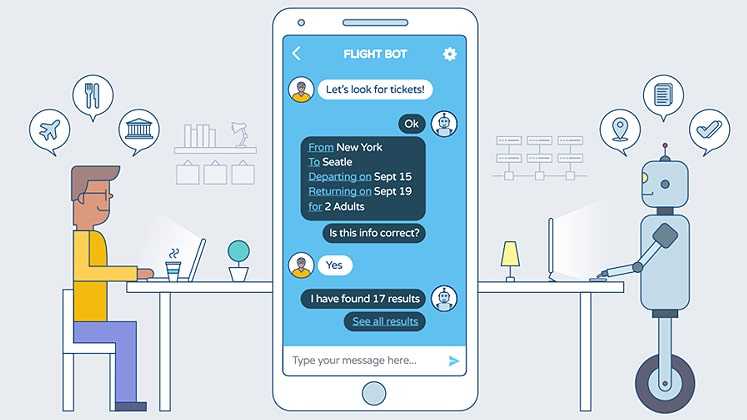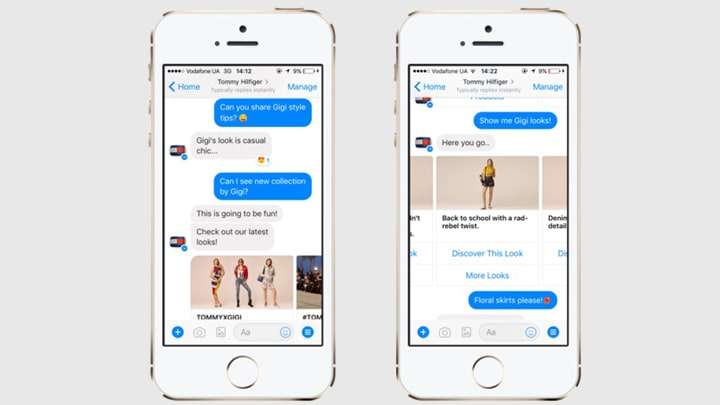
Chatbots, initially originating from ‘Chat robots’, are computer programs or artificial intelligence designed to convincingly stimulate human conversation. These programs, also known as smartbot, conversational bot, chatterbot, interactive agent, conversational interface, conversational AI, or artificial conversational entity are provided with the combination of deep learning technologies like text-to-speech, automatic speech recognition and natural language processing, which enable them to simulate human conversation and dialogues.
The term ‘ChatterBot’ was originally coined by Michael Mauldin , in 1994, to describe these conversational programs. Today, most chatbots are accessed via virtual assistants such as Google Assistant and Amazon Alexa , via messaging apps such as Facebook Messenger or WeChat , or via individual organisations’ apps and websites.This article summarises how this AI-based technology can let the retailers deliver a seamless shopping experience to their customers.
Best retailers are the ones who take responsibility of their offerings before, during and after the products have been sold. For this, different retailers have adopted different strategies and technologies, Chatbot being one of them. Amazon is one of the best examples, whose customer care service uses AI-trained chatbots which make conversation with the customers and reply to their queries with solutions. These chatbots are capable enough of solving small issues on their own. However, in some situations, when the issue needs any human intervention, these robots transfer the case to human customer representatives.
With digitisation moving at such a fast pace, these chatbots have become very versatile and they can now do a number of tasks including being a fashion consultant for the customers.They are now trained using artificial intelligence which makes them capable of recommending matching outfits and can style an entire look based on the input provided by the users. The chabots, after asking a couple of questions to the users, can predict what is exactly that they are looking for. There are few retailers who have implemented ‘conversational chatbots’ for improving customer experience.
Tommy Hilfiger, in partnership with supermodel Gigi Hadid, implemented the technology back in 2016. The company’s fashion assistance chatbots are capable of providing many options to pick up from, thus creating a seamless shopping experience for their customers. These chatbots work by asking few questions to the users based on which they predict what is that the customer wants. The options also allow customers to browse through styles, enabling the chatbots to assist the shoppers in selecting an outfit.
These chatbots keep the customers involved and live up to the designer’s statement of ‘going directly to the consumer’. Moreover, these chatbots are trained enough to style an entire look based on the input provided by the users. If the customer is looking for some particular style/look, these chatbots can accurately put together a fresh Tommy Hilfiger look which includes shoes and accessories from the brand. Also, there are brands like H&M and Levis, which are using chatbots to recommend matching outfits and pick up the perfect jeans.

The AI capabilities of these chatbots have made them trained enough to reply with the correct recommendations and output. However, to enhance the experience and make it more realistic, there are ‘augmented reality-powered chatbots’ which rely on advanced AI like face tracking and recognition so that products can be virtually applied in the real image. A best example of this is the beauty retailer Nykaa that gives users the leverage of applying lip shades in real time to test before buying. Also, in 2017, ModiFace, a company that creates ‘augmented reality tech’ for beauty brands and Estee Lauder, a beauty retailer, collaborated to launch an augmented reality powered chatbot. These chatbots let the customers choose their lipshades by taking a small quiz. The use of this technology helped the users to see how the lip shade will look on them by performing ‘a unique search-by-colour capability’ that allows shoppers to search for lipsticks by taking a photo of any object. The experience is similar to the testing of sample lip shades — except that in this case, the customer is not in the store.
The back-end technology that goes behind creating such seamless experience for the customers is the artificial capabilities that are fed into these software. This allows the chatbot softwares to work by analysing the structure of messages, identifying keywords and AI helps them to understand, pick up keywords and make conversation like humans to deliver a service. Training these chatbots with fashion-related database is what makes them personal stylists. These are therefore capable of processing the information and coming up with the most appropriate recommendations and answers for the consumers.
Solutions Available!!
There are companies that are specifically dedicated to provide fashion-related solutions to the retailers. One such company is Streamoid Technologies Pvt. Ltd , a visual-based search and discovery services provider for e-commerce and publishing industry. The company offers search and styling recommendations, acting as a highly trained stylist and shop-assistant rolled into one.
These chatbots are equipped with technologies such as computer vision, that has the ability to understand various content such as colour, patterns and shapes of an image. Its deep learning provides the ability to understand images and texts, combined with various learning neural networks, making fashion AI toolkit extremely powerful. Streamoid’s FashionNet model, is therefore, built with a unique data-set of over 12 million fashion products and the in-depth understanding of fashion and its vocabulary gives context to searches and accuracy to recommendations. Moreover, its sophisticated natural language understanding has the capability to infer meaning from conversational speech or text and therefore understands a customer’s needs and accordingly replies with the perfect answer.
The company has a set of services for e-commerce, chatbots and animator which link print or digital images to relevant content online.
Its AI-based c hatbots named as ‘Stylebots’ assist in product discovery, styling advice and customer support. These let the customers type and ask for a particular product, eliminating the hassle of applying filters, sliders, radio buttons and check-boxes making the product discovery process much more easier. Also, they provide styling recommendations to the users. Users can ask about what to wear with a check shirt and these reply with suggestions to choose from. At last, these chatbots have an advantage over a human agent – operational 24X7 helpline that provides customers with solutions to their queries and delivers personalised supports.
Their AI capability is so powerful that they can understand the difference between a dress shirt and a shirt dress. “You can interact with it, like you would with a highly knowledgeable fashion sales assistant,” claimed the company.
With their e-commerce services of automatic outfit generation, the online retailers can enhance their sales with cross-selling.These recommend the customers the entire look that the customer may prefer buying along. The ‘Image Search’ makes the product discovery process much more easier as the customers can capture an image and load it in the app to search for more similar options. Also, these are capable of displaying similar options of a product that can recommend customers more options.The turbo charge search option incorporates text, voice and images into search.
Their technologies have been tried and tested by brands like Pothys, a leading saree retailer in Tamil Nadu.They implemented the smart recommendation technology for their online business and to cater to their international customers.
“Since we have to serve online customers virtually, we wanted the best virtual assistants for them. The quality of Streamoid’s similar product recommendations are very good. 3 per cent CTR’s jumped to 12-13 per cent overnight and it has gone up to as high as 19 per cent during festival season,” said Varun Pothy, CEO, Pothys.
Moreover, the online venture of the Aditya Birla Group,Abof, also used Streamoid’s product and outfit recommendations. The recommendation engine was trained on Abof’s styles, based on outfits modeled in their catalog as well as their internal style guide. The self-learning system also learns about global trends as well as the customers, so the recommendations become increasingly personalised.
“The performance of Streamoid’s product recommendation system over the other providers has been indisputable. Abof.com users are 20 per cent more likely to stay on the website after visiting, spending 21 per cent more time and are 60 per cent more likely to purchase,” mentioned the brand.
Another interesting example is IBM XPS which is aimed at assisting customers for recommendations before making a research. The machine learning and AI capabilities deliver the best expert advice that seem to be coming from a personal stylist.
Their natural language processing ability helps consumers discover and refine products’ selection based on their response to a series of questions. IBM XPS guides customers along their journey asking relevant questions such as how and when the desired product is expected to be used; the results are more accurate and faster than the traditional search and filtering technology that is currently in use by many retailers. Moreover these help the businesses with better customer-driven insights to inform about product development, marketing and merchandising decision.
IBM XPS uses chat, messaging and other natural language interfaces to understand customers’ intent in real time, to drive relevant and contextual interactions that help improve sales. Unlike other product recommendation engines, this conversation with the shopper is what enables IBM XPS to refine its recommendations and deliver a more accurate result.
One such example of IBM XPS implementation is Northface jacket brand. The interface asks you a small question about your preferences and then delivers you a few options that meet your requirements. The system asks you questions such as where and when you will be using the jacket, who is the jacket for, the colour options for it and so on. making the decision much more easier for you. Based on your answers, it shows the available collection to you that makes your buying decision easier.
Chatbots are revolutionising the way retailers have been using technology to deliver seamless shopping experiences to their customers. These are the need of the current hour to the known fact that the competition in the market has created a need to be different from the retailers and also the tech-savvy customers love having everything on their fingertip. Moreover, the shopping decisions are often difficult decisions to be made alone; these personal stylists make it easier for the customer to decide and therefore increase the sale of the retailers.
Moreover, today customers prefer to chat over the messenger than over calls, and hence, these have become the first choice of the customer. Therefore, a chatbot customer care service is something that is much more preferred by the customers as these are fast and 24X7 available without any long waiting time.
There are different modes which can be used as per the business requirement like live chat or social media bots, some mechanism to analyse e-mails and suggest answers, smart FAQ intelligent browsers, smart search etc. However, no matter what the mode is, one thing that remains the same is the mechanism that allows them to process text communication and chose the most suitable element from a database to offer products, advise or become a professional help desk, sales support or prepare answers in the form of FAQs.

Post a Comment